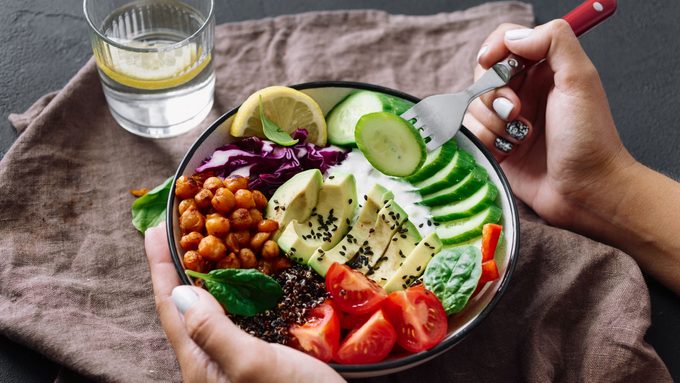How Mindful Eating Can Help You Lose Weight
The key is to become more aware.

Ever plow through a stack of cookies, barely looking away from your computer screen? Gobbling up food is pretty much the opposite of mindful eating, a growing movement that encourages adherents to pay attention to what they eat and how they eat it. It’s not about crash dieting, but rather thinking about hunger levels (“How hungry am I as I unwrap this treat?”) and savouring food (“What flavours and textures do I feel when I take this bite?”), which may have the benefit of helping you lose weight associated with unhealthy eating habits. For starters, adding this food to your breakfast has all-day weight loss benefits.
Best Health asked two mindful eating experts—Ronna Kabatznick, board member of The Center for Mindful Eating and assistant professor in the psychiatry department at the University of California, San Francisco, along with Camille Nghiem-Phu, a Toronto-based naturopathic doctor, to explain this growing trend.
Best Health: What is ‘mindful eating’?
Ronna Kabatznick: Mindful eating is both an ancient and modern practice of being fully present for what, when and how you are eating. Food is a blessing and a gift to be savoured and appreciated, particularly given that it is so easy to take it for granted.
BH: What does mindful eating entail?
RK: A basic concept of mindful eating is becoming intimately aware of when you feel hungry and what hunger feels like. Mindful eating also means that there is no right or wrong way to eat. Each person’s eating needs fit their physical, emotional and spiritual needs, as well as the circumstances and situations they finds themselves in. For instance, you may eat differently on vacation than you do at home. The basic concept of mindful eating comes down to being fully aware of choice—you don’t have to be a slave to habits. You can also become aware of what situations and emotions trigger the desire to overeat and seek alternative ways to handle these situations.
BH: What are your best tips for eating mindfully?
RK: Start with opening your refrigerator and making a mental note of everything you see. Notice your inner response—is it awe, fear, appreciation, tension? Pick up one item, such as a piece of fruit. Really look at it, as if you’re looking at it for the first time, noticing its colour, size, shape, smell and texture. Then pick up another item, perhaps something that comes in a box or jar. Notice those qualities and what feelings are aroused. Notice what you’re drawn to eat, what stimulates craving and desire to eat [or] aversion. You can also notice labels, saying aloud all of the contents of the food, including pronouncing all of the food preservatives in it. Cooking meals yourself (as opposed to dining out) is also a healthy habit for controlling your weight.
Then, there is the practice of mindfully eating something like a raisin. Be aware of what goes on in your mind when you see a raisin, all of the likes and dislikes. Feel the raisin. Appreciate the shape, ridges, textures and smell. Then put the raisin in your mouth, and notice what that feels like. Then bite into it, feeling and tasting the burst of flavour, before mindfully swallowing it. For many people, desire arises–why just one raisin? Why can’t I eat a handful? Others may feel shocked that eating just one raisin is so satisfying that they don’t need any more. They also may realize they find themselves thinking they’d prefer a brownie. None of these thoughts are good or bad. Just noticing them and seeing them as thoughts, as mental events, is a very powerful experience. It means that we don’t need to ‘eat’ those judgments or experiences. We can just notice them as thoughts and feelings.
Sometimes we get so consumed by desire, we miss the experience of eating. Before we know it, we’re staring at an empty plate, yet we feel like we haven’t even eaten. Don’t beat yourself up—that habit has been around a long time. It takes a lot of patience to break it and establish new ones. Besides, there will always be another meal—it’s not a one-shot deal. Having healthy meals already prepared (use our weekly meal plan as a guide) will prevent you from reaching for those unhealthy snack foods.
BH: If you find that mindful eating is getting difficult, what can you do to stay the course?
RK: You can notice the weight of the food utensil in your hands, slowly put food in your mouth, then focus on savouring and chewing [each bite].
BH: How does mindful eating work in your body?
Camille Nghiem-Phu: I often counsel patients on how to eat: proper chewing, timing of meals and recognizing feelings of fullness. When we eat, the stomach organ releases parts of the food to the small intestine in short spurts. When the small intestine senses food entering, it releases a hormone called cholecystokin (CCK), into the bloodstream that tells the stomach to slow down the rate of those short spurts. CCK also tells our brain that we’re full and can stop eating.
Eating too quickly and mindlessly does not allow the small intestine to keep up, and therefore the CCK won’t be released into the bloodstream to make us feel full. It’s important to chew and eat slowly so our digestive organs have an idea of what’s going on, and can release the appropriate hormones and enzymes for optimal digestion. We will always feel full with smaller meals when we eat slowly and mindfully. Remember the old saying, It takes 20 minutes for your brain to figure out what your stomach has been up to!
Mindful Eating in Canada
Curious to learn more? Check out the Centre for Mindfulness in Toronto for mindful-eating workshops, which are available both in person and online.
Still not seeing weight loss results? Keep in mind that you need to get a certain amount of sleep if you want to lose weight.




